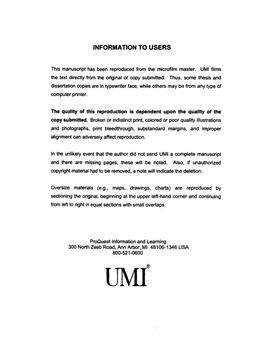| dc.contributor.advisor | Glatzhoter, D. T., | en_US |
| dc.contributor.author | Snow, Albert George. | en_US |
| dc.date.accessioned | 2013-08-16T12:18:38Z | |
| dc.date.available | 2013-08-16T12:18:38Z | |
| dc.date.issued | 2002 | en_US |
| dc.identifier.uri | https://hdl.handle.net/11244/498 | |
| dc.description.abstract | Three topics that are of interest to scientists in polymer electrolytes are: (1) ion-ion interactions; (2) ion-polymer interactions; and (3) how these interactions correlate to ionic conductivity. A spectroscopic study of LPEI and LPEI:MTf (M = Li+ or Na+, Tf is triflate, CF3SO3-) was undertaken using infrared spectroscopy, Raman spectroscopy, calorimetry, and AC complex impedance measurements. LPEI is a highly crystalline polymer with extensive hydrogen bonding interactions. Ionic speciation in LPEI:LiTf decreases from 25% "free" ion at a N:Li ratio of 20:1 to 13% at a 10:1 N:Li ratio. LPEI-NaTf systems however, did not follow the same trends seen for the LPEI-LiTf systems. The ionic speciation of LPEI-NaTf consisted of mainly ion pairs for all salt concentrations investigated. The highest conductivity obtained was 3 x 10-6 S/cm at 60° C for 20:1 LPEI-LiTf. The ionic speciation of LPMEI:MTf (M = Li+ or Na+) decreases from 36% "free" ion at a N:Li ratio of 20:1 to 24% at a 5:1 N:Li ratio. LPMEI-NaTf systems however, did not follow the same trends seen for the LPEI-LiTf systems. The ionic speciation of LPMEI-NaTf actually showed an increase of "free" ions, 27% to 52% for the 20:l and 5:1 sample compositions, respectively. The highest conductivity that was obtained was 3 x 10-6 S/cm at 60° C for the 20:1 LPEI-LiTf. The ionic speciation of LPEI-G2:LiTf samples changes from 50% "free" ion at a N:Li ratio of 20:1 to 26% at a 5:1 N:Li ratio. The highest conductivity that was obtained was 7 x 10-5 S/cm at 60° C for the 20:1 O:Li sample. | en_US |
| dc.description.abstract | Synthesis of linear poly(ethylenimine) (LPEI) was accomplished by hydrolysis of commercially available poly(2-ethyl-2-oxazoline). Linear poly( N-methylethylenimine) (LPMEI) was made from LPEI using the Eschweiler-Clarke reductive methylation. Linear poly(N-2-methoxyethylethylenimine) (LPEI-G1), linear poly(N-2-(2-methoxyethoxy)ethylethylenimine) (LPEI-G2), linear poly(N-2-(2-(2-methoxyethoxy)ethoxy)ethylethylenimine) (LPEI-G3), and (3,6-dioxaheptyl)diethyl amine (DEA-G2) were all synthesized by a reductive alkylation using the corresponding carboxylic acid. | en_US |
| dc.description.abstract | Future investigations using LPEI-G1, LPEI-G3, and their respective model compounds will be carried out to evaluate their potential as polymer electrolyte hosts. All polymer systems discussed in this thesis can be crosslinked to form elastomeric networks. These elastomeric networks have better physical and mechanical properties than the parent polymers and may be used to improve the mechanical stability of the polymer electrolyte hosts. | en_US |
| dc.description.abstract | Polymer electrolytes are materials that contain dissolved salts in heteroatom-containing polymer hosts. The ion-ion and polymer-ion interactions have been extensively studied using poly(ethylene oxide) (PEO) as the polymer electrolyte host with many different dissolved metal salts. PEO-salt systems, however, like to form crystalline polymer-salt complexes which drastically reduces ionic conductivity. Changing the heteroatom from oxygen to a softer heteroatom such as nitrogen, may suppress the formation of polymer-salt crystalline complexes. | en_US |
| dc.format.extent | ix, 150 leaves : | en_US |
| dc.subject | Chemistry, Polymer. | en_US |
| dc.subject | Crystalline polymers. | en_US |
| dc.subject | Ion-ion collisions. | en_US |
| dc.subject | Polyelectrolytes. | en_US |
| dc.subject | Chemistry, Organic. | en_US |
| dc.title | Synthesis and spectroscopic studies of polymer electrolyte hosts: Linear poly(ethylenimine), linear poly(N-methylethylenimine) and linear poly(N-2-(2-methoxyethoxy)ethylethylenimine). | en_US |
| dc.type | Thesis | en_US |
| dc.thesis.degree | Ph.D. | en_US |
| dc.thesis.degreeDiscipline | Department of Chemistry and Biochemistry | en_US |
| dc.note | Source: Dissertation Abstracts International, Volume: 63-07, Section: B, page: 3304. | en_US |
| dc.note | Major Professor: D. T. Glatzhoter. | en_US |
| ou.identifier | (UMI)AAI3059898 | en_US |
| ou.group | College of Arts and Sciences::Department of Chemistry and Biochemistry | |
